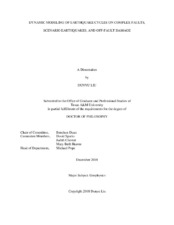| dc.contributor.advisor | Duan, Benchun | |
| dc.creator | Liu, Dunyu | |
| dc.date.accessioned | 2019-01-23T20:49:05Z | |
| dc.date.available | 2020-12-01T07:32:46Z | |
| dc.date.created | 2018-12 | |
| dc.date.issued | 2018-11-12 | |
| dc.date.submitted | December 2018 | |
| dc.identifier.uri | https://hdl.handle.net/1969.1/174527 | |
| dc.description.abstract | The dissertation is devoted to developments of numerical methodologies to simulate physical processes of various earthquake phenomena and their applications. In the first study, we develop a dynamic earthquake simulator based on finite element methods (FEM) to model dynamics of geometrically complex faults governed by the rate- and state- friction over multiple earthquake cycles. The simulator combines a dynamic FEM code EQdyna for the coseismic dynamic phase and a newly developed static FEM code EQquasi for the quasi-static phases of earthquake nucleation, post-seismic and inter-seismic processes. Both FEM codes are parallelized through MPI to speed up computations. The dynamic earthquake simulator includes fully dynamic rupture propagation and can handle complex fault geometry. Earthquake cycles on a 3D strike-slip fault with a bend are simulated.
In the second study, deterministic ground motions up to 0.5 Hz from a set of spontaneous dynamic ruptures of Mvw 7.5 scenario earthquakes on a 160-km right-lateral seismic gap in North China Basin (NCB) have been simulated. Self-similar heterogeneous initial stresses on the fault and a high-resolution 3D velocity structure in NCB have been used. Self-similar stresses result in complex rupture behaviors such as jumped/triggered ruptures due to large stress variations. The directivity effect on peak ground velocity is significantly reduced by self-similar heterogeneous stresses, because of frequent acceleration and deceleration of rupture fronts. Basin induced surface waves from the four bowl-shape basins in the study area amplify and prolongate ground motions, particularly within the one between Tianjin and Beijing.
In the last study, dynamic ruptures of a 3D strike-slip fault with a bend are simulated. Drucker-Prager plasticity is applied to model the off-fault damage associated with stress heterogeneity induced by dynamic ruptures through a bend. Induced/reactivated shear mesoscale
subsidiary faults and microcracks indicated by the beach balls are associated with observed orientations of such features in the Northern Branch of the San Gabriel Fault. The numerical models confirm that dynamic ruptures through the bend will induce the prominent set of subhorizontal fractures at shallow depths near the bend. The direction of rupture propagation determines the locations of the subhorizontal fractures. | en |
| dc.format.mimetype | application/pdf | |
| dc.language.iso | en | |
| dc.subject | earthquake dynamic rupture | en |
| dc.subject | earthquake cycle | en |
| dc.subject | off-fault damage | en |
| dc.subject | fault geometrical complexity | en |
| dc.subject | ground motion simulation | en |
| dc.title | Dynamic Modeling of Earthquake Cycles on Complex Faults, Scenario Earthquakes, and Off-Fault Damage | en |
| dc.type | Thesis | en |
| thesis.degree.department | Geology and Geophysics | en |
| thesis.degree.discipline | Geophysics | en |
| thesis.degree.grantor | Texas A & M University | en |
| thesis.degree.name | Doctor of Philosophy | en |
| thesis.degree.level | Doctoral | en |
| dc.contributor.committeeMember | Sparks, David | |
| dc.contributor.committeeMember | Chester, Judith | |
| dc.contributor.committeeMember | Hueste, Mary Beth | |
| dc.type.material | text | en |
| dc.date.updated | 2019-01-23T20:49:05Z | |
| local.embargo.terms | 2020-12-01 | |
| local.etdauthor.orcid | 0000-0001-6740-3080 | |


